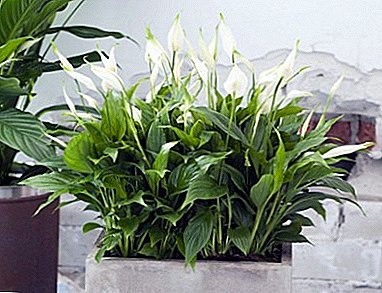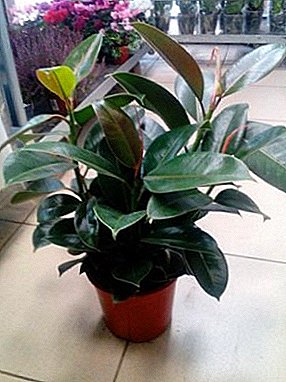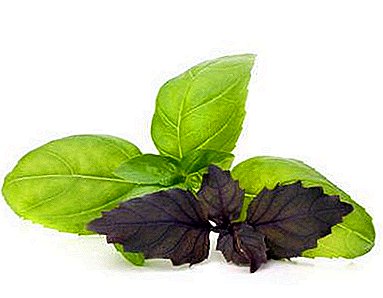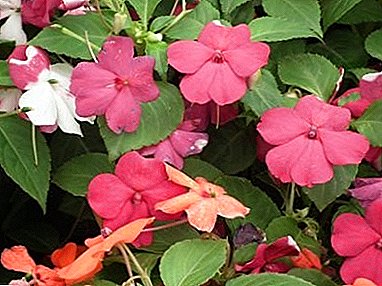 Ficus microcarp Moclame (Ficus microcarpa Moclame) is a compact representative of a large group of ficuses. This dwarf variety is very popular for interior decoration as well as landscapes. A simple and unpretentious plant still has a number of features in the care, which we will discuss later.
Ficus microcarp Moclame (Ficus microcarpa Moclame) is a compact representative of a large group of ficuses. This dwarf variety is very popular for interior decoration as well as landscapes. A simple and unpretentious plant still has a number of features in the care, which we will discuss later.
Description and photo home flower
The tree comes from the East, but it takes root in most countries in temperate, tropical and subtropical geographic zones. The main difference from other ficus relatives is the presence of aerial roots, more round leaves. The bark of the tree is gray, slightly textured. The leaves are oval, green, solid and glossy.
Did you know? The alternative name of the plant is microcarp, which is translated from ancient Greek as “small seeds” (“micro” - small, “karpos” - fruit). This name stuck because of its flowering, during which seeds appear on a tree with a diameter of only 0.5-1 cm. Small, rounded red berries are not edible. At home, it blooms extremely rarely, as it is a very energy-intensive process.
It is a popular choice for home and office, like the other rubber plants. The reason for this - the brevity of appearance, ease of care. However, the microcarp has another trump card in the sleeve - this tree is used as bonsai, which makes it at the same time an interesting interior solution, a pet and an exclusive gift. 
Familiarize yourself with the nuances of growing ficus mikrokarp, Benjamin, lyre-like and rubber-conic ficus.
How to choose a ficus in the store
The ideal time to buy a plant is spring. Most likely, after the acquisition, the ficus will need to be transplanted, and the earlier the transplant, the stronger Moklame will be before the onset of the first cold weather.
When choosing a ficus in the store, pay attention to the condition of the plant. The flower must be healthy and well maintained. Leaves will help to define it. The presence of stains, twisted leaves, bald areas of the tree suggests that care was not sufficient.
If the flower is poured and root rotting has gone, it will be extremely difficult to withdraw the plant. Also pay attention to the presence of pests. Turn the leaves and inspect their back side.  The presence of parasites is not fatal, but if you bring an infected plant into the house, your home flowers may soon suffer. Ideally, the ficus should match its description. Any deviations indicate a failure and are a reason to think twice before buying.
The presence of parasites is not fatal, but if you bring an infected plant into the house, your home flowers may soon suffer. Ideally, the ficus should match its description. Any deviations indicate a failure and are a reason to think twice before buying.
Where to place the ficus after purchase
The plant is very modest in size, but demanding location. Ficus grows in a natural environment in a tall tree, but at home it rarely grows above 1.5 m. It is not recommended to rearrange the pot more than twice a year (winter - summer).
Important! A relatively frequent problem is dropping leaves after purchase in protest. Do not think that you bought a low-quality flower. As you know, the ficus Moclame does not like to change the place, the pot and relive the change of lighting, which is almost inevitable when moving. To prevent this from happening, try to approach the issues of transportation carefully.

Loves the shadow, indirect diffused light. The complete absence of sunlight will lead to slower growth and foliage fall, and an overabundance of sunlight will lead to burns on the leaves. For planting outdoors, the eastern and western sides of the house are best suited. The rest of the ficus unpretentious and not capricious, even suitable for beginners.
Temperature and humidity
The optimum temperature in the summer season is + 25 ... +30 ° С. In winter time, it is possible to lower the degree to + 16 ... +20 ° С, but at the same time, it is of fundamental importance not to allow overcooling of the soil (pot).
We recommend to get acquainted with the popular types of ficuses.
If your ficus is on a cold floor or windowsill, it is recommended to put it on a stand (wood panel, folded fabric, etc.) and wrap a pot with a warm cloth. Humidity for ficus is suitable 50-70%, which coincides with the natural level for our latitudes.
Like many other plants, it is recommended in the summer to increase the intensity of spraying with settled water at room temperature. In the summer you can arrange Moclame hygienic shower with a gentle warm stream of water, but not more than 1 time per month. Excess water from the pot tray should be poured. 
Lighting
Figuratively speaking, this ficus is a real conservative. Difficult experiencing a change of place, he also does not like changes in lighting. Find a place in the room with scattered rays of the sun and put there a ficus.
Important! Some growers recommend in the winter to illuminate the plant with additional fluorescent lamps, prolonging the day. 7-10 hours - optimal daylight hours.
If he got accustomed there, do not continue to continue the experiments. It is on the requirements for lighting that the recommendation is based to land Moclam at the western or eastern part of the building.
Soil requirements
Neutral or non-acidic primer is suitable for this miniature ficus. If you prefer to create a soil mix yourself, you will need sand, turf, leaf soil in equal quantities.  Also, you can add charcoal in the same proportion. Do not forget to put in the bottom of the pot drainage in the form of pebbles, rubble or special purchased pellets.
Also, you can add charcoal in the same proportion. Do not forget to put in the bottom of the pot drainage in the form of pebbles, rubble or special purchased pellets.
It will be useful for you to read about how to pick up the soil for ficus, what are the basic properties of the soil, how to improve soil fertility, how to independently determine the acidity of the soil, as well as how to deoxidize the soil.
Ficus Moclame: home care
The plant is not only easy to care and pretty, but also safe. It cleans the air, suitable for allergies and completely non-toxic. Even if you have pets, do not worry about potentially gnawing leaves.
Firstly, this ficus leaves most animals indifferent. Secondly, nothing will happen to a pet after such a gastronomic experiment.
How to water the plant
The amount of watering ficus depends on the temperature and season, like many other plants. In general, the mode of watering is moderate, on average 2-3 times a week.  In the summer, sprinkling is necessarily added to the watering. However, always look at the ground. If the soil is dry when immersing a finger in the ground by 2-3 cm, water it. In winter, watering should be minimal, no more than once every 2 weeks, you should not splash at all.
In the summer, sprinkling is necessarily added to the watering. However, always look at the ground. If the soil is dry when immersing a finger in the ground by 2-3 cm, water it. In winter, watering should be minimal, no more than once every 2 weeks, you should not splash at all.
We advise you to read about how to properly water the ficus at home.
Do you need feed
Periodically it is necessary to feed fertilizers. In the spring, add a universal fertilizer according to the instructions on the package. In the summer you can stimulate the growth of foliage with nitrogenous fertilizer. In winter, it is necessary to ensure the plant complete rest.
Cropping and crown formation
Formation of the crown allows you to grow well-groomed beautiful home ficus. It is better to start pruning in the spring so that new branches have a chance to get stronger and survive the upcoming cold weather.
Did you know? In antiquity in the East, this plant was a kind of sacred tree. It was believed that the ficus and the owner establish a close energetic connection, exchange spiritual forces. Ancestors believed that Moklame brings master wisdom and fertility, devotion and love.
 The peculiarity of this ficus - the growth of terminal (upper) kidneys inhibits the growth of axillary (lateral), and vice versa. To grow a tree like a poplar or cypress, you can not make especially formative cuttings - this is its natural form. However, for a tall, well-proportioned, tall, slender tree, it is necessary to trim the side branches, thereby stimulating the growth of the tree in height.
The peculiarity of this ficus - the growth of terminal (upper) kidneys inhibits the growth of axillary (lateral), and vice versa. To grow a tree like a poplar or cypress, you can not make especially formative cuttings - this is its natural form. However, for a tall, well-proportioned, tall, slender tree, it is necessary to trim the side branches, thereby stimulating the growth of the tree in height.For a lush bush, trim the crown of a tree. Removal of any apical buds automatically stimulates the growth of lateral branches and inhibits the growth of the upper ones.
It is from this ficus that a bonsai tree is made. To obtain the correct form of plants need:
- Crop main central escape.
- Wash out juice from a slice, wipe, place powdered with activated charcoal.
- When the length of the side branches will be equal to the length of the central one, they should also be cut, rub the sections with coal.
- The flowerpot is constantly turned in place by the different side to the sun so that it does not get a bevel.
 Thus, it turns out a magnificent miniature tree.
Thus, it turns out a magnificent miniature tree.Did you know? By Feng Shui, Ficus brings harmony and tranquility to the house. Perhaps because of its demands for order and conservatism, the plant actually teaches the host to discipline, contemplation and order.
How often to change the soil and transplant the plant
Immediately after the purchase, you can make a transplant, because due to the relocation, the ficus and so received stress, you should not create a new pot in the near future.
In addition, there are other signs that it is time to change the pot:
- roots covered the ground tightly;
- vylazyat roots of the pot;
- plant in a temporary flowerpot after purchase.
It is best to engage in transplanting in spring or summer. At other times, the ficus may not catch on and get sick. As a rule, young animals are transplanted once a year in order to change the pot to a larger one.  Even in the period of active growth, there is often no point in doing this - the ficus is growing quite slowly. An adult plant is transplanted no more than once every 2-3 years in order to replace the soil. Moreover, it is desirable to carry out a change of soil transshipment, rather than a full transplant.
Even in the period of active growth, there is often no point in doing this - the ficus is growing quite slowly. An adult plant is transplanted no more than once every 2-3 years in order to replace the soil. Moreover, it is desirable to carry out a change of soil transshipment, rather than a full transplant.
Breeding features
The best time for breeding ficus - spring. As in the case of cutting branches, it is necessary to allow the plant to get stronger before the onset of cold weather. Most often, new plants are obtained by cutting.
The sequence of actions is as follows:
- Find cuttings 10-15 cm, on which the crust has already begun to form.
- Cut off with a sharp knife or blade (not scissors!) At an angle.
- Immediately rinse out the sap from the cuttings.
- Lower branches, leaves and other shoots to cut.
- Put the cutting in a dark opaque container with separated water at room temperature in a warm place. Important: water should not reach the leaves so that the process of decay does not begin. You can also throw 1 tablet of activated carbon into water for disinfection.
- The plant must be constantly in a humid environment. In the absence of such a stalk should be regularly sprayed.
- After 2-3 weeks, the first roots appear, and the shoot can be planted in a mixture of perlite, sand and peat in a ratio of 1: 1: 1.
- A transplant in a permanent pot is desirable in three months.
Learn more about the most popular methods of breeding ficus at home, as well as how to pick up a pot, and transplant ficus.
Another option is to plant the cutting immediately into wet soil. Some experts prefer this method, since the risk of rotting the cutting practically disappears.
If you do not have a tropical climate and not a greenhouse, cover the cutting with a jar or a package before rooting. You can also speed up the process using special additives-rooted. It is possible to grow a plant from seeds, but this method is the longest and requires treatment with a number of special preparations.
Possible pests and ficus diseases
Moklame is resistant to diseases and parasites, but not immortal. If you follow the simple rules of care, ficus does not bring trouble. Plant condition may deteriorate after or during flowering. In this case, the berries should be removed. 
Diseases
Symptoms and their causes:
- gray spots on the leaves - excessive watering and, as a result, root decay;
- leaf fall - insufficient watering or stress after moving;
- curling leaves - sunburn.
Like ficus, the number of useful indoor plants include: chlorophytum, aloe, geranium, laurel, kalanchoe, chrysanthemum, cactus, pelargonium and sansevieria.If the above symptoms appear, correct the root cause.
Pests
As for pests, the list of parasites is very classic: aphid, scab, and mealybug. 
Did you know? Ficus mikkarpa very useful. Leaves make tinctures and decoctions for the treatment of joint inflammation (arthritis, radiculitis), as well as diseases of the mammary glands (mastitis). The ficus itself perfectly filters the air, has disinfecting properties.They are cleaned with both insecticides and simple soapy water. A miniature tree that is easy to clean and not capricious is an excellent choice for interior decor. Observing simple rules of care, you can grow this handsome bonsai style.












